Introduction
Are leadership and management different?
Can you teach someone leadership?
What is the difference between leadership and management?
These are some questions that confuse everyone, especially in the early stages of one’s career. The situation worsens because every expert has different answers and opinions to these questions.
But, one common thing they all agree on is that leadership and management are different, and leadership skills can be taught if one is willing to learn.
Let’s dig deep into the nitty-gritty details of leadership vs management discussion and clear the confusion between the two.
What is leadership?
Leadership is the ability to guide people toward a shared vision or goal. Leadership aims to set a vision, inspire people, and guide them to achieve the objectives. A leader is typically seen as someone who influences change and drives innovation, often focusing on long-term goals.
Marcus Buckingham and Ashley Goodall in their book, Nine Lies About Work, define leadership, “This is the true lesson in leading from the real world: a leader is someone who has followers, plain and simple. The only determinant of whether anyone is leading is whether anyone else is following.”
Every organization needs leaders. In a business context, leaders are usually people who are in executive management or C-level positions, such as chief executive officer (CEO), chief technical officer (CTO), and chief operations officer (COO). However, it is not mandatory that one has to reach a certain position to be a leader. One can inspire and lead even without a position and ascend to the top positions.
Leadership does not come with the title. It is an attribute one possesses and can develop at any position.
Most famous examples of leaders in the business world are Tesla CEO Elon Musk, Microsoft founder Bill Gates, Apple founder Steve Jobs, and Amazon CEO Jeff Bezos.
What makes a good leader?
“If your actions inspire others to dream more, learn more, do more, and become more, you are a leader.” — John Quincy Adams
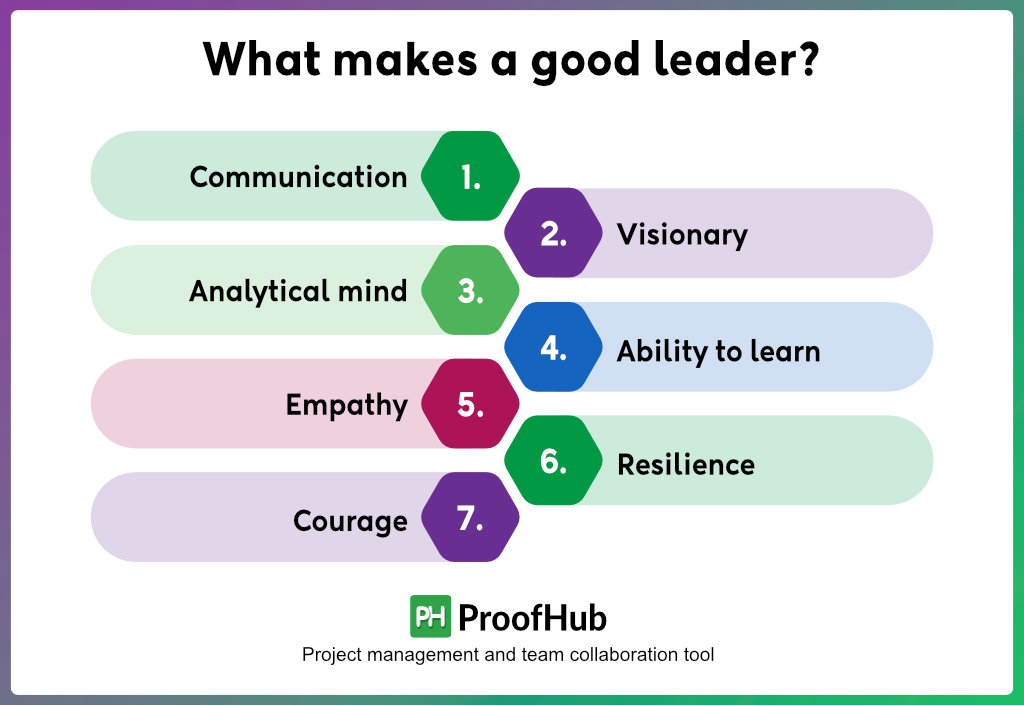
Some certain qualities and skills make one a good leader. Look at the top leadership qualities that make you a good leader.
1. Communication
Effective leadership is directly related to effective communication. It is because without it you cannot understand what others are saying and respond in a manner that resonates with them. That’s why all great leaders are good at communication.
They have a great ability to listen to people patiently and then respond in a manner that tells others they pay attention to what others have said. This helps you understand people around you, build a relationship, and articulate your vision into words that people from different backgrounds can understand.
2. Visionary, creativity, and curiosity
A good leader is a visionary. They have this unique capability to see solutions and opportunities that others cannot identify. Curiosity and creativity are the two qualities that fuel vision because with curiosity, you get to learn about new things, and with creativity, you brainstorm and create a vision.
3. Analytical mind
A leader cannot make all decisions with a gut feeling or irrationality. They need a strong analytical mind to analyze the problem, break it down to find its root cause, and make rational decisions based on analysis. Thus, analytical prowess makes one a good leader.
4. Ability to learn
No one individual can know everything or have an answer to all the questions. The common quality of all good leaders is a willingness to learn. They have this positive, flexible, and adaptable mindset of learning new things.
Thus, they focus on learning and finding solutions to problems whenever they face unknown challenges. This learning agility makes them great leaders.
5. Empathy
Being able to understand and connect with others at an emotional level is among the key qualities of good leaders. You need empathy for that. It helps you to step into your team member’s shoes and understand how they are feeling.
When you understand your and others’ emotions, you can make sensible decisions considering others’ well-being. This makes you a great leader and helps you build trust with your team members.
6. Resilience
You do not always succeed as a leader. Sometimes, initiatives have results that are opposite to what you have thought of. In those cases, your resilience comes into play. Being resilient is a common quality of a good leader. Even the greatest leaders fail, but their resilience to get back and start again keeps them in the fight and helps them succeed in adversaries.
7. Courage
In leadership positions, you need to make decisions, and you often have to sail through uncharted waters. Even after much research, you are not sure your initiative will succeed. Thus, you need a lot of courage to make decisions. It is not just about making business decisions; you need courage to resolve high-stakes conflicts at your organization or make policies because you do not know what will happen.
What are different leadership styles?
“Leadership and learning are indispensable to each other.” — John F. Kennedy
A leadership style refers to a leader’s methods and behaviors when directing, motivating, and managing others.
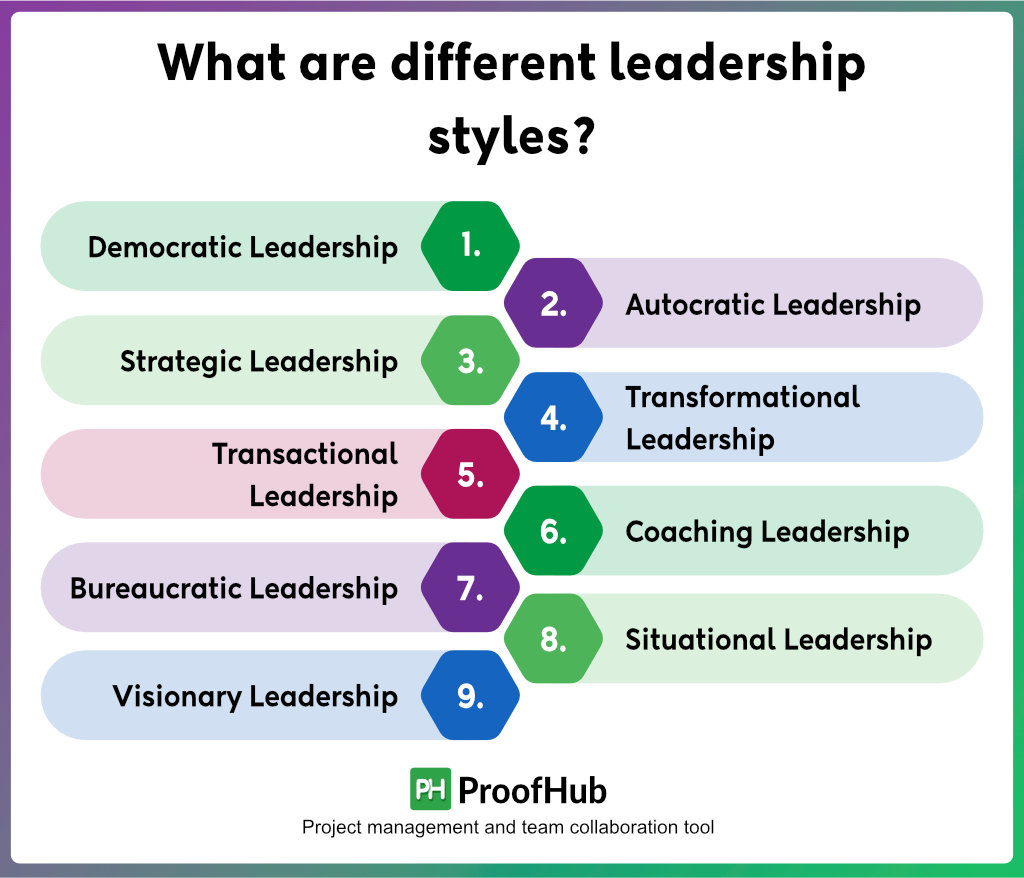
There are a variety of ways to lead people. This leads to various leadership styles and theories. Let’s have a look at them.
1. Democratic Leadership
Democratic leadership is a type of leadership where a leader makes decisions based on the input from each team member. This type of leadership is ideal for scenarios when you need the input and expertise of others around you.
2. Autocratic Leadership
Autocratic leadership is a type of leadership where a leader makes decisions without taking input from anyone. This type of leadership is ideal for scenarios when a leader has full confidence in their decision-making.
3. Strategic Leadership
Strategic leadership focuses on making decisions based on opportunities in the market to achieve organizational long-term goals. It involves evaluating your competitors’ strategy, finding strategic advantages, and aligning your leadership to maximise the opportunities.
4. Transformational Leadership
Transformational leadership includes transforming and motivating employees with words to work towards the company’s objectives. In this type of leadership, a leader focuses on gaining employees’ trust and inspiring them to do their best.
5. Transactional Leadership
In this type of leadership, a leader seeks to motivate, inspire, and lead the employees through a sophisticated system of rewards and punishments. The leader sets specific rules for giving rewards, monitors the employees’ performance, and rewards them if they meet the goals.
6. Coaching Leadership
This style of leadership focuses on empowering the employees through coaching. A leader focuses on training an individual, giving them opportunities to nurture talent, and sharing feedback to make improvements.
7. Bureaucratic Leadership
Bureaucratic leadership runs by the book of rule. This type of leadership is adopted in large organizations where decisions are made using standard company policy or past practices. It is a fixed and rigid type of leadership.
8. Situational Leadership
Situational leadership refers to the type of leadership style adapted to fit a particular situation. It involves analyzing specific situations, evaluating the best possible action, and adjusting your approach to solve the situation. Opposite to bureaucratic leadership, it is a flexible approach and recognizes that change is the only constant.
9. Visionary Leadership
As the name suggests, this type of leadership is based on vision. A leader inspires and guides their team toward achieving a shared vision.
How to identify your leadership style and use it to your advantage?
Understanding your leadership style has huge advantages because now you can gain more knowledge about it and master it. But the first step is to identify your leadership style.
Here are three steps to find your leadership style:
1. Self-assessment
Write down your values because your instincts and values play a key role in determining what kind of a leader you are. Start writing down what you stand for, how you see things, and how you would manage the situation. A great way to get started is to write down the names of leaders you respect. It will help you understand your inclination to leadership style.
2. Study leadership styles
There are many leadership styles. We also discussed this earlier in this post. Study these leadership styles and learn about the attributes associated with them. For example, an autocratic leadership style suits you best if you have high intellect and can see things others cannot.
On the other hand, if you are good at utilizing resources, you would want to use a transformational leadership style to inspire, motivate, and guide people.
3. Request feedback
If you are unsure about your leadership style or how people see you as a leader, seeking feedback from the people you manage is a great idea. Anonymous feedback will help you know many things about your leadership.
So, these are three simple ways to identify your leadership styles.
Want to know more? Check out the most common leadership styles & their advantages.
Leadership vs Authority
The main difference between leadership and authority is how they influence and guide others. Leadership relies on trust, respect, and vision to inspire, motivate, and encourage people to work toward a shared goal. On the other hand, authority is the formal right or power given by an organization or position to direct and control others.
Leaders gain followers through personal influence rather than formal power. Whereas, authority can make decisions because of their title or role rather than personal influence.
Both leadership and authority hold positions that can impact the people’s lives and the organization’s future.
What is management?
Management is the act of controlling things and dealing with people. The purpose of management is to ensure that resources are used effectively to achieve the set goals.
Management focuses on organizing, controlling, and ensuring that day-to-day operations run smoothly. Managers focus on implementing the strategies set by leaders and ensuring tasks are completed efficiently.
Mary Parker Follett says, “Management is the art of getting things done through people.”
Just like leaders, every organization needs managers. It is because a leader’s role is to think about what to do ahead, while a manager’s role is to execute the leader’s vision and turn it into reality.
In the business context, there are three levels of management: top, middle, and low.
- Top: It includes roles like CEO, CTO, COO, and CFO. They make administrative decisions that affect the entire organization. They are not involved in day-to-day activities.
- Mid: It includes roles like Regional Manager and General Manager. They work with top- and low-level management to ensure organizational goals are achieved.
- Low: It includes roles like Supervisor and Team Leads. They work with team members to meet goals determined by upper-level management.
Just like leadership, there are different management styles.
Want to learn more? Read about the best management styles!
What does a manager do?
“The manager’s job is to build a team that works well together, support members in reaching their career goals, and create processes to get work done smoothly and efficiently.” – Julie Zhuo
The manager’s role is to execute the vision into reality. For that, a manager creates a plan, organizes resources accordingly, monitors and controls the execution, and motivates the team to give their best to achieve organizational goals.
Here is a brief explanation of the day-to-day functions of a manager:
1. Planning
A manager creates a project plan, defines cost, and sets a timeline. The purpose of a manager is to convert the ideas into reality. It can happen only when you have a clear list of tasks and an action plan to achieve them. A manager sets goals and creates an action plan to achieve them.

2. Organization
When working on a vision, you need resources. Managers organize resources and hire people. Managers evaluate the type of work, divide it into achievable tasks, and effectively delegate it to staff.
The organization aims to improve efficiency and ensure the achievement of the objectives.
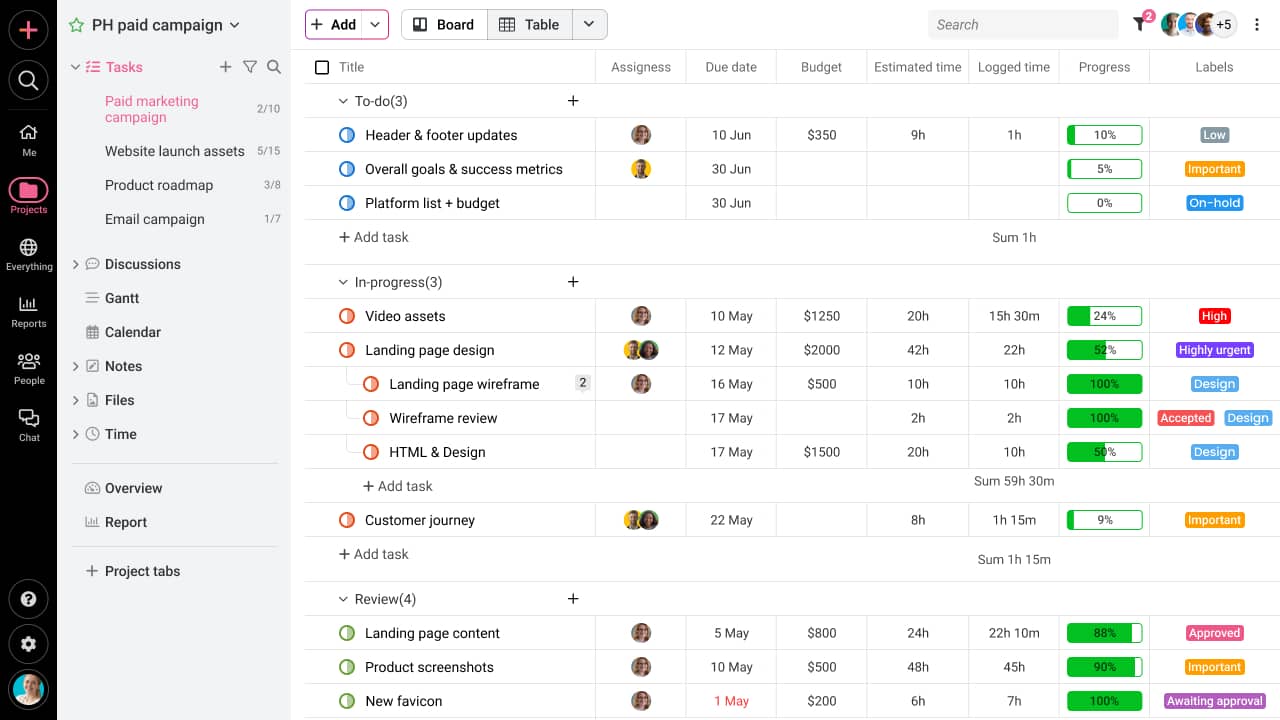
3. Monitoring and control
A manager’s role is to create and execute a project plan. And it cannot happen successfully without controlling, guiding, and navigating the team.
Thus, a manager monitors the progress, tracks the efforts, and controls the employees to make efforts in the right direction to achieve the project objectives within time and budget.
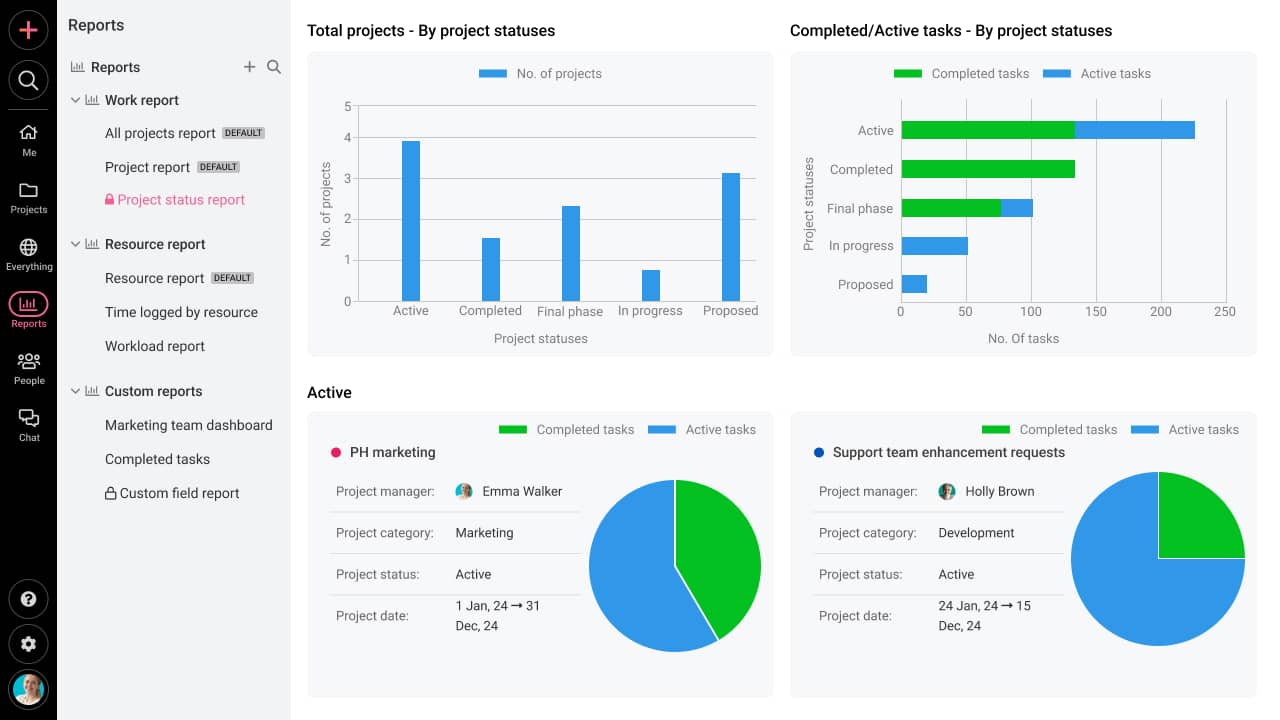
4. Motivating
The manager’s role is not all about controlling but supporting the team. A manager motivates the team to work hard to achieve the desired objectives.
The role of a manager is to ensure teams are engaged and committed to achieving the company’s objective, they have all the resources to do the job, and their concerns are heard.
Management vs. Micromanagement

Some managers confuse control in management with micromanagement. Micromanagement is defined as a manager’s excessive supervision and control of employees. This leads to all sorts of troubles for a manager, such as poor performance, high turnover, and lower job satisfaction. It is because employees do not feel valued and trusted. Therefore, it is important to establish the line between control and control to an extreme degree.
The opposite of micromanagement is when a manager supervises the employees but trusts them to do the job. A macro manager does not interfere with employees’ work and allows them to take responsibility for it. It results in improved performance and better job satisfaction.
What is the difference between leadership and management?
The main difference between leadership and management is that leadership focuses on inspiring, motivating, and guiding people towards a goal, often emphasizing innovation. On the other hand, management concentrates on planning, organizing, and overseeing processes to achieve specific objectives by maintaining control within an organization.
Simply put, a leader asks questions of what and why, whereas a manager focuses on how and when. Thus, you can see the difference between the two.
One is focused on thinking and setting direction, and the other is focused on action and executing the vision. One embraces chaos; the other seeks control and stability.
Have a look at the key differences of leadership vs. management.
1. Psychology
Leadership is concerned about developing goals and driving change, whereas management seeks to implement the processes to ensure articulated goals are executed. Thus, a manager seeks a stable environment and controls various project factors to accomplish the articulated goals. On the other hand, a leader embraces chaos, considers change the only constant, and adapts and evolves to define the vision.
2. Functions
Leadership defines what to do ahead, whereas management oversees day-to-day operations. A leader thinks and decides for the organization, and a manager takes action and executes the plan.
A leader is responsible for setting direction in the organization, and a manager controls team members.
3. Roles
The role of a manager is defined, and it comes with a fixed set of responsibilities. A manager has a specific job description, and they use the systems and processes for oversight in an organization.
On the other hand, a leader’s role is fluid. A leader is responsible for creating and articulating a vision and seeking to motivate and inspire people through their actions. You are not a leader if you cannot encourage others to do their best. Leadership is more of a quality not subjected to a title or position.

The similarities between leaders and managers
Just like the differences, there are some similarities between leaders and managers. It is because the nature of their many responsibilities is the same.
For example, they both have to deal with the people around them, and they both have to articulate what they think.
Here are the key similarities between leaders and managers:
- Communication: Both leaders and managers need great communication skills. A leader needs it to articulate their vision, and a manager must clearly define roles, responsibilities, and goals.
- Decision-making: A leader needs to decide about the organisation’s direction, and a manager makes decisions about project operations.
- Motivation: A leader needs to motivate the entire organization, whereas a manager needs to motivate a team to give their best.
- Adaptability: Both leaders and managers are involved in dealing with unprecedented situations. Thus, they need to be adaptable and open to new ideas.
- Interpersonal skills: Both managers and leaders need to handle people around them. Thus, they need interpersonal skills to build positive relationships with people.
These are some of the similarities between leaders and managers.
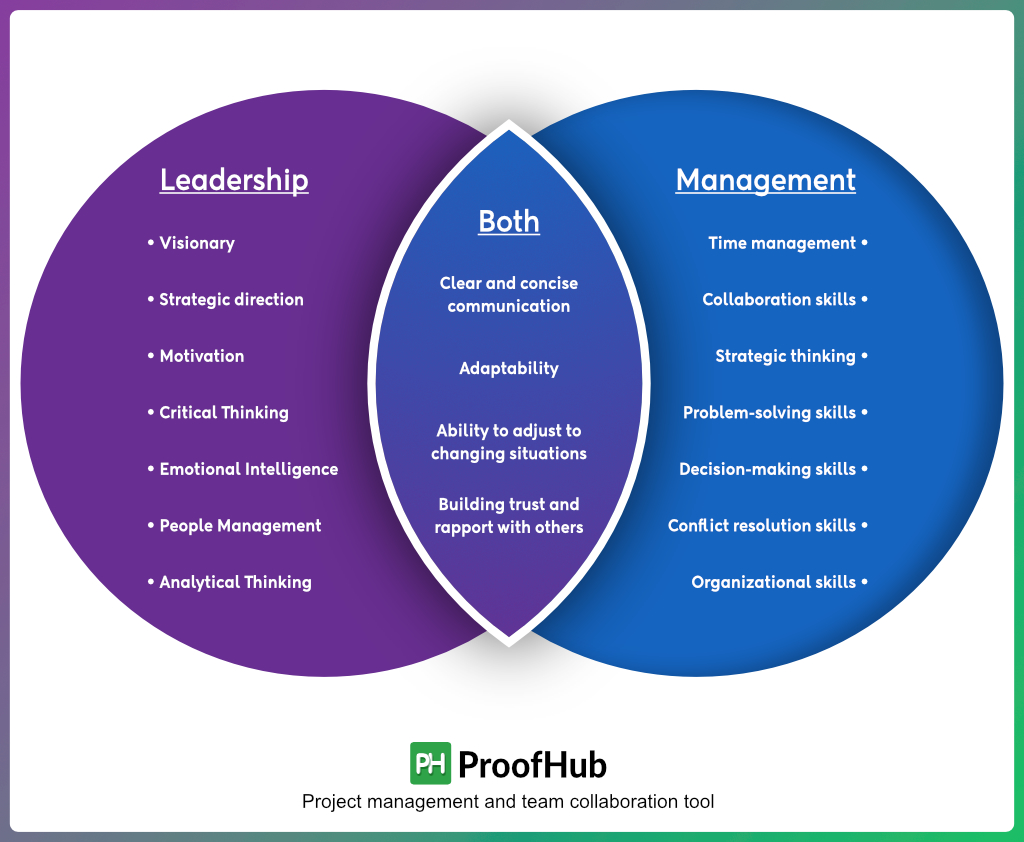
Leadership vs. management skills
The responsibilities of a leader and a manager are different from each other. For example, a leader is not involved in day-to-day operations, but a manager needs to hold people accountable for their daily tasks. Thus, each requires different skills to fulfil their responsibilities successfully. Look at the most important skills for a leader and a manager.
Leadership skills
A leader needs the following skills to lead effectively:
- People management skills: A leader has to listen, communicate, and inspire. Thus, they need good communication skills, active listening, and the ability to inspire others. All of these skills are part of people management skills.
- Decision making: Leaders are the decision makers. They should be able to make rational decisions. Thus, a leader needs strong analytical thinking skills to make informed decisions.
- Emotional intelligence: A leader has to deal with people. Thus, they need emotional intelligence to understand other emotions and respond sanely without reacting.
- Adaptability: A leader should be flexible in their mindset to adapt to the changing requirements. It helps them to respond to the change better.
- Critical thinking: A leader must be visionary to become a good leader. For that, they need to have a mind that can think critically and learn new things. It helps build a vision and think creatively.
Read more: Top leadership skills you need to lead your team successfully
Management skills
A manager needs the following skills to manage day-to-day operations effectively with ease:
- Organization skills: A manager needs strong organization skills to manage resources, including time, money, and people. It helps them utilize the resources efficiently, work productively, and create an effective project plan to achieve the organization’s goals.
- Delegation: A manager has to work with the team. Thus, they need good delegation skills to distribute the work and use resources fully. They need strong observational skills to delegate work to the right people at the right time.
- Collaboration: Without effective collaboration, a manager cannot execute the project plan. Thus, they should know how to communicate with team members, when to share information, and create an environment that facilitates collaboration.
- Conflict resolution: When a group of individuals work together, it is natural to have some resistance and conflicts. A manager’s responsibility is to resolve the conflicts in the team and make them work together as one unit.
- Time management: A manager has multiple responsibilities and is responsible for completing the project on time. That’s why they need strong time management skills to manage their workload and complete projects on time.
Read more: What makes a good manager (the ultimate guide of dos and don’ts)
How to develop leadership and management skills?
“Leaders are made, they are not born. They are made by hard effort.” — Vince Lombardi
The good thing is you can build both leadership and management skills. All you have to do is make efforts in the right direction. Have a look at the actionable tips to develop leadership and management skills.
1. Enroll in courses
The best way to quickly build leadership and management skills is to enrol in leadership learning and development training courses. The expert teachers will teach you the skills you need to become a good leader and a manager.
2. Mentorship program
If you are a working professional, the best way to build leadership or management skills is to enrol in a mentorship program or job shadowing with people at the leadership and management levels. It will help you learn how to make decisions in the real world and learn skills from observation.
3. Keep learning
If you want to develop any skill, first you need to learn it. Numerous online self-learning resources can teach you the basics of any skill. Invest time in learning and develop your leadership and management skills.
When to use each skill?
If you are in a position where you have to fulfil the responsibilities of both manager and leader, then you need to understand when to use each skill to achieve the company’s objectives. Have a look.
Use leadership skills
- When a new direction is needed
- During times of change
- To motivate and inspire teams
Use management skills
- To maintain day-to-day operations
- To solve operational problems
- To ensure tasks are completed on time and within budget
Leadership vs management: which is more important?
Every organization needs both leadership and management. It is because leaders are the ones who set the vision, while managers are the ones who execute the vision. Thus, you need both to achieve organizational objectives.
However, it is important to understand that leaders can be good managers, and good managers can be good leaders. Though, it is not necessary for a manager to be a good leader and a leader to be a good manager. It is good if you have both skills. It will make you a complete leader and manager.
Start leading and managing your company’s operations rightly with ProofHub. Get your 14-day free trial
FAQs
Can a manager be a leader?
Yes, a manager can be a leader if they have the skills to become a good leader. If you show interest in leadership and exhibit leadership qualities, your organization’s top management will award your leadership responsibilities.
Which characteristics are associated with leaders rather than with managers?
The most popular characteristics associated with leaders are vision, taking responsibility, leading with clarity, people management, negotiation, and integrity. A manager may have all the qualities usually exhibited in a leader’s behavior.
Can a person be both a leader and a manager?
Yes, a person can be both a leader and a manager. You need leadership and management skills to become a successful leader and manager.

